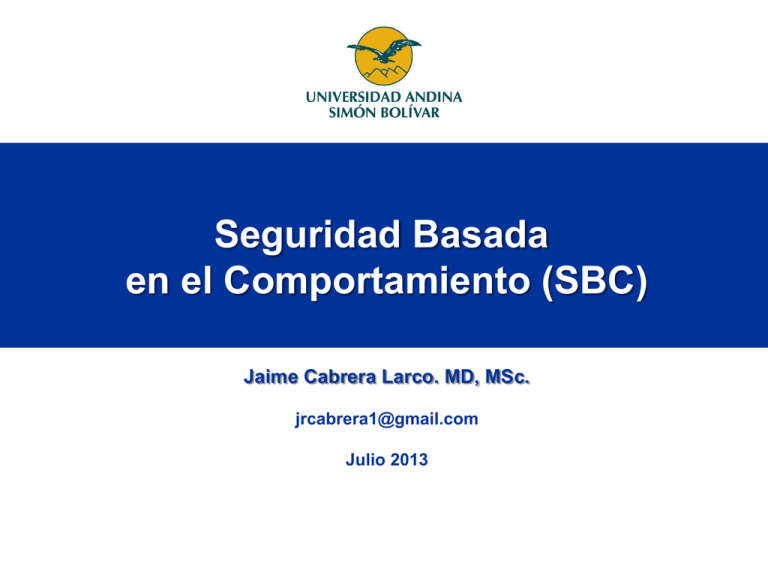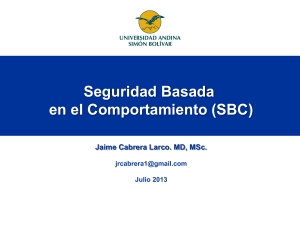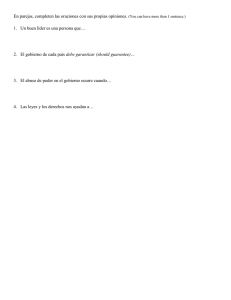Seguridad Basada en el Comportamiento (SBC)
Anuncio

Seguridad Basada en el Comportamiento (SBC) Jaime Cabrera Larco. MD, MSc. [email protected] Julio 2013 1. 2. 3. 4. 5. DEFINICIÓN Y DELIMITACIÓN DEL PROBLEMA. BASES CIENTÍFICAS DEL COMPORTAMIENTO HUMANO METODOLOGÍA (EXPERIENCIA PERSONAL) ANÁLISIS E INTERPRETACIÓN DE RESULTADOS CONCLUSIONES 6. MEJORA CONTINUA 1. Definición y delimitación del problema. 1.1 ¿Por qué nos accidentamos? “Las acciones inseguras de las personas son responsables de la mayoría de los accidentes”. 1.2 Iceberg de los Incidentes Entendiendo: reacción y prevención Lesiones incapacitantes Lesiones no incapacitantes Daños materiales Incidentes DESVÍO Comportamientos de riesgo investigación de es unesproceso reactivo,reactivo, mientras La La investigación depérdidas pérdidas un proceso que el análisis del comportamiento es preventivo mientras que el análisis del comportamiento es preventivo 1.3 El Impacto de los Comportamientos en la Seguridad Accidentes o Tasa de Accidentes Ingeniería Sistemas Comportamientos Tiempo 1.4 CURVA Niveles en el Desarrollo de DE unaBRADLEY Cultura Cero Accidentes Libre de Lesiones vs. Niveles Desarrollo de la Cultura Organización INTERDEPENDIENTE (Equipos de alto desempeño) Reactivo • Seguridad a partir de los instintos naturales • Falta de involucramiento de la Gerencia / Supervisión Dependiente • Compromiso de la Gerencia / Supervisión • Seguridad como condición de empleo • Miedo/ Disciplina • Reglas/ Procedimientos • Control y objetivos dictados por la Supervisión • Capacitación Independiente • Involucramiento personal • Interiorización • Valores personales • Cuidado consigo mismo • Práctica, experiencia y hábitos • Reconocimiento individual Interdependiente • Colaboración • Contribuidor a nivel de “equipo” • Ayuda a otros a cumplir y a mejorar • Guardián de los otros • Orgullo organizacional Lograr un decrecimiento del IFA en la organización, incluyendo la eliminación de los procedimientos y prácticas (comportamientos) perjudiciales para la seguridad de manera que no permanezcan en el sistema, mediante la aplicación de la SBC. 2. Bases Científicas del Comportamiento Humano Papel de los antecedentes y las consecuencias Definiendo el Comportamiento Definición que usaremos “Todo acto observable y medible” Ejemplos de Comportamientos Observables • La posición de trabajo correcta para elevar una carga manualmente. • La forma en que se ejecuta determinada operación. • El estado en que queda algo después de hacer determinada operación utilizándolo. Bases de las Ciencias del Comportamiento ANTECEDENTES CONSECUENCIAS Es o son los eventos causales que preceden al comportamiento. Son los resultados del comportamiento para el individuo. UNA PREGUNTA CLAVE: ¿ POR QUÉ SE PRODUCEN LOS COMPORTAMIENTOS, POR LOS ANTECEDENTES O POR LAS CONSECUENCIAS? ¿Por qué se atiende al teléfono? ¿Por oír el sonido (timbre) o… por saber qué quiere el que llama? Bases Científicas del Comportamiento Tanto los antecedentes como las consecuencias influyen en el comportamiento, pero…Ambos lo hacen de forma diferente Los Antecedentes influyen en los comportamientos indirectamente, primariamente porque sirven para predecir a las consecuencias. • Las Consecuencias controlan a los comportamientos de forma directa y poderosa. • Ejemplos de Antecedentes • • • • • • • Señal de tránsito. Un cartel en el lugar de trabajo. Instrucciones del supervisor. Reglas y normativas. Modelos (otras personas lo hacen). Capacitación y entrenamiento Información e inducción ¿Son todos ellos suficientes para garantizar un comportamiento seguro? Ejemplos de Consecuencias • Recibir retroalimentación después de una tarea. • Recibir felicitaciones o una distinción. • Recibir reprobación o sanción. • Ser escuchado y tomado en cuenta. • Sufrir un accidente. Análisis Comportamental: entendiendo EL CICLO ACC ¿Por qué hacemos lo que hacemos? Comportamiento Antecedente • Viene antes del comportamiento • Dispara el comportamiento • Un acto observable Consecuencia • Viene después del comportamiento • Muda la probabilidad de repetición del comportamiento Factores que afectan las consecuencias Tiempo • Inmediato / Tardío Probabilidad • Cierta / Dudosa Significado • Positivo / Negativo Análisis Comportamental: entendiendo EL CICLO ACC Estudio de Caso ANTECEDENTE COMPORTAMIENTO • No disponible CONSECUENCIA Tiempo Prob. Sign T D - • Conservación NO USO DEL • Daños y lesiones • Prisa PROTECTOR • Reprensión T D - • Economía de tiempo I C + • Confort I C + I C + I C + • Adiestramiento ineficiente FACIAL AL • Percepción del peligro OPERAR EL • Otros también no usan • Ausencia de supervisión • Percepción del peligro ESMERIL • Mejor visión • Aprobación de los colegas Consecuencias Las Consecuencias más efectivas 1. Potencian la conducta (positivas) 2. Se entregan inmediatamente 3. Son ciertas 3. Metodología El Proceso de Seguridad Basada en el Comportamiento es una herramienta de gestión NO solo de seguridad y se encuentra centrada en la observación de las conductas seguras realizadas por las personas en el lugar de trabajo y está destinado a reforzar y mejorar el desempeño seguro de todos los colaboradores 3.1 ELEMENTOS FUNDAMENTALES COMPROMOMISO E INVOLUCRAMIENTO Compromiso y Liderazgo Todos SBC Observación, Feedback y Seguimiento Participación vertical y horizontal Líderes Gerentes 3.2 ESTRUCTURA, ROLES, RESPONSABILIDADES Líder de Proyecto Capacitación Observadores Seguimiento Respuesta Comité de seguridad. Herramientas de relevamiento Acc Correc y Prev Procedimientos Base de Inventarios de Comportamientos y análisis de observaciones Conjunto de observadores y Líder de proyecto Accidentes GOR Desarrollar planes de acción Comunicación Pizarras Folletos Generar Posibles soluciones Sistema 3.3 CAPACITACIÓN Y ENTRENAMIENTO Prevención de los Riesgos Laborales mediante la implantación del proceso de Seguridad Basada en el Comportamiento (SBC) • Seminario gerencial de introducción, seguido de capacitación de observadores • Calibración del proceso de observación e identificación de desvíos; • Soporte para adaptación de los procedimientos, adiestramientos y conductas a la filosofía de la seguridad comportamental; • Proveer herramienta informatizada de tratamiento de datos; • Mentoring operacional y coaching técnico. 3.4 PROCEDIMIENTO, INSTRUCTIVOS, FORMATOS SBC es el cuidado mutuo y activo, es decir, todos nos preocupamos por nuestra seguridad y por la de nuestros compañeros de trabajo. ¿Cómo lo hacemos? SWEETS Safe Workers Enter Exit Together Safely Trabajadores “seguros” logran el éxito con seguridad 21 Critical Behaviours 21 Comportamientos Críticos Body Position Body Use & Ergonomics 1 Line of fire Linea de fuego 2 Pinch points Puntos de pellizco 3 Eyes on path Ojos en el camino 4 Eyes on task Ojos en la tarea 5 Ascending & Descending 6 Working at Heights 7 *** Lifting & Lowering *** Elevación y descenso 8 Twisting 9 10 11 Tools & Equipment 12 13 Subiendo&Bajando Trabajos en altura Girando Pushing / Pulling Empujando y tirando Overextended, Cramped & Overexertion Sobrextensión, Hacinamiento &Sobresfuerzo Repetitive & Awkward task Movimiento repetitivo & “tarea compleja” Selection, Condition & Use Selección, condición & uso Guarding Vigilando, Supervisando Procedures followed Procedures 14 PPE 15 Eyes Ojos 16 Hearing 17 Hands Manos 18 Body Cuerpo 19 Housekeeping Orden y limpieza Work Environment 20 Mobile Equipment 21 Seguimiento de procedimientos Oídos Walking/Working Surfaces Superficies de tránsito o trabajo Forklifts Montacargas o carretillas elevadoras 3.5 OBSERVACIÓN Y RETROALIMENTACIÓN La base para que tenga éxito el Proceso de Modificación de Conductas es la observación regular de las conductas seguras. Por lo tanto, el proceso de observación es el elemento más importante de la SBC. 1. Prepárese: planifique 2. Observe: activamente 3. Dialogue y brinde retroalimentación: inmediata, enfatizar en lo positivo. Documente 4. Registre 5. Haga seguimiento y mejora continua OBSERVACIÓN Y RETROALIMENTACIÓN (REFORZANDO EL COMPORTAMIENTO POSITIVO) ConsecuenciasActiva, Corta Duración Observación: • Reacción de las personas • Postura de las personas • Equipo de Protección Personal • Herramientas y equipos • Procedimientos • Orden y limpieza • Desviaciones/Perdidas Retroalimentación: Consecuencias Inmediata, positiva, llegue acuerdos y compromisos Habla.. Escucha.. Actua.. Consecuencias Importancia de la Retroalimentación • Influye el comportamiento • Proporciona informaciones sobre el desempeño • Es una consecuencia • Comunica un patrón • Ayuda en la percepción del riesgo • Aumenta la propia observación • Fortalece la cultura de seguridad • Descubre barreras ocultas 3.6 REGISTRO DE CONDUCTAS REGISTRAR es simplemente ANOTAR lo que vimos. Al observar conductas podemos REGISTRAR las acciones que vemos en el momento o acciones que ya ocurrieron y podemos constatar sus resultados. 3.7 SEGUIMIENTO Y MEJORA CONTINUA • Visite el sitio de trabajo frecuentemente(2/mes) • Haga seguimiento a los acuerdos • Actualice la información en el sistema • Revise periódicamente los procedimientos • Tome acciones con respecto a los reportes • Analizar los datos, comunicar, mejorar Esquema Metodológico Consecuencias Análisis Estadístico y MEJORA CONTINUA Ahora Vamos a armar El Sistema Completo Mentoring y Coaching Estructura y competencia Inventario de Conductas Aprendimos a Observar Identificar las barreras hacia la seguridad, eliminarlas y ejecutar los planes de acción Realizamos Observaciones Tomamos nota de lo importante y elaboramos planes de acción Aprendimos a dar feedback 4. Análisis de Datos 4.1 Cuenta Rótulos de fila de Mes Enero 96 Febrero 79 Marzo 206 Abril 296 Mayo 259 Junio 305 Julio 134 Agosto 123 Septiembre 203 Octubre 259 Noviembre 314 Diciembre 151 Total general 2425 4.2 Rótulos de fila ACTO NEGATIVO CONDICIÓN NEGATIVA POSITIVA Total general Cuenta de ACTO / CONDICIÓN 1349 810 266 2425 4.3 Rótulos de fila AMBIENTAL BIOLÓGICO ERGONÓMICO FÍSICO MECÁNICO PSICOSOCIAL QUÍMICO Total general Cuenta de RIESGO 1 46 110 1050 974 13 61 2255 4.4 Rótulos de fila CERRADO PENDIENTE Total general Cuenta de STATUS 2135 283 2418 5. Conclusiones 5.1 Genera Ventajas al Sistema de Gestión Consecuencias Global y de SST Para ParalalaEmpresa EMPRESA • Disminución de las tasas de accidentalidad • Mejora del clima laboral • Fortalecimiento de la imagen de la empresa Para el TRABAJADOR • Sentirse parte de la seguridad • Protección de su integridad física • Aprendizaje de nuevas herramientas • Mejoramiento de la autoestima Consecuencias 5.2 Estrategia del Proceso Comportamental Mentoring y Coaching 5% Clase Demostrativa 10% Lectura 20% Audio-visual 30% Demostraciones 50% Discusión en grupo • Soporte para los observadores vigilando la perfecta aplicación del proceso comportamental; • Soporte para la gerencia operacional vigilando la identificación de los principales grupos de desvíos y estrategia para detenerlos 75% Aprender haciendo 90% Enseñar a otros Pirámide del aprendizaje: Tasa promedio de retención de la información Fuente: National Training Laboratories, USA Preocupación y atención Etapa 3 Hábito Etapa 1 Ansiedad Etapa 2 Reconocimiento y Respuesta al riesgo Conocimiento y Habilidad SIN GESTIÓN COMPORTAMENTAL 5.3 Logra mejora comportamental: atención y respuesta al riesgo Reconocimiento y Respuesta al riesgo Preocupación y atención Conocimento y Habilidad Reconocimiento y Respuesta al riesgo 43 Familiarización con la tarea Antiguo Etapa 1 Ansiedad Etapa 2 Reconocimiento y Respuesta al riesgo Etapa 3 Hábito CON GESTIÓN COMPORTAMENTAL Principiante 6. MEJORA CONTINUA 6.1 GESTIÓN SBC DEFINIENDO CAUSA ADECUACIÓN FALTA DE APTITUD INSTRUMENTO DE FORMACIÓN DE ACTITUD “poder hacer” HABILITACIÓN FALTA CAPACIDAD “saber hacer” 4 2 6 1 FALTA DE INFORMACIÓN O NORMAS 5 MOTIVACIÓN INCORRECTA “querer hacer” 3 COMUNICACIÓN CONDICIONES DE TRABAJO INADECUADAS INGENIERÍA/DISEÑO 6.2 LISTA CHEQUEO ESPECÍFICA SBC 6.3 AUDITORIA INTERNA SBC Section # Question Section Roles & Are roles and responsibilities for BBS clearly 1 defined and understood? Repsonsibilities 2 Has the management established clear KPIs and targets for the BBS programme? Management Leadership 3 Programme Design & Observation Strategy Are employee representatives consulted in the design of the BBS programme? 5 Are observation-feedback sessions carried out in a positive way? 6 Are records generated for each observation? 7 Are all work groups and shifts observed regularly? Do behaviours associated with higher-risk activities have greater focus? Has the management established clear KPIs and targets for the BBS programme? Targets should be defined and cascaded for the numbers of observation-feedback sessions. Other targets should be defined based on assessed need, eg compliance with specific behaviours , BBS training, action plan closure, observer coaching. Interview programme owner and Factory Manager and confirm site target. [For factories, DCs and R&D sites 6 observations per employee per year is considered reasonable, 12 per employee per year is considered good]. 3 Do all members of the management team carry out regular observation-feedback sessions? The management team should be trained and active observers. They should observe staff at all levels, including other management team members. Management observation-feedback sessions should be of high quality and set the standard for the site. Review training records, and records of observations. Observe management observations if possible. Interview management team members. 4 Are employee representatives consulted in the design of the BBS programme? Employee representatives should be involved in the original design, and ongoing review, of the programme to ensure it is effective and reflects workers' concerns. Review records of programme design and of ongoing reviews, including meeting minutes. Interview employee representatives. 5 Are observation-feedback sessions carried out in a positive way? Obervers should carry out observation-feedback sessions in an open and transparent way. The feedback should recognise and reinforce safe behaviours and challenge at-risk behaviours. Review BBS training and observation records. Observe observation-feedback sessions. 6 Records should include the name of the observer but not the Are records generated for each observation? name of the observee. Depending on the local approach, some spontaneous observations may not need to be documented. 7 Are all work groups and shifts observed regularly? Sites should ensure that all work groups/teams and shifts are regularly observed. Managers and team leaders should be observed, as well as shop floor staff. Temporary employees and contractors should also be observed. Check numbers of observations for different work groups, shifts, type of employee/contractor. 8 Do behaviours associated with higher-risk activities have greater focus? Sites should identify higher-risk activities and associated behaviours. Sites should ensure these activities and behaviours receive appropriate observation and feedback, eg through scheduling or targeting of observations. Review identified higher-risk activities and check vs risk assessments, incident data, etc. Check numbers of observations for higher risk activities, eg machinery interventions, work at height, tasks under permit-to-work. Interview BBS programme owner. 9 Does the site promote spontaneous observation-feedback sessions?* Observation-feedback sessions will often need to be planned. However, spontaneous/unplanned observations should also be encouraged. Review BBS training. Check records of spontaneous observation-feedback sessions. Interview a range of employees and the BBS programme owner. Is there a training programme to ensure competency of BBS observers? Training should include: 1) Observation, feedback and coaching skills; 2) Safe behaviours relevant to activities to be observed. It should include practical training, and be designed to steadily increase numbers of BBS observers. Review BBS training materials and records. Interview BBS programme owner. All staff should understand the concept, process and benefits of the programme, and cooperate positively during observationfeedback sessions. Observe obervation-feedback sessions. Review BBS training materials and records. Interview BBS programme owner. Management Leadership Programme Design & Observation Strategy Training & Competency of 11 Is the BBS programme explained to all staff and contractors? Obervers Is there a system for monitoring and 12 improving the quality of observationfeedback sessions?* 9 Does the site promote spontaneous observation-feedback sessions?* 13 Data System 10 Is there a training programme to ensure competency of BBS observers? Training & Competency of 11 Is the BBS programme explained to all staff and contractors? Obervers Is there a system for monitoring and 12 improving the quality of observationfeedback sessions?* 13 Is observation data collated and periodically analysed? Data System 14 Is observation data communicated and used to improve safety and health? Monitoring and Does the site regularly audit and review its 15 BBS programme?* Review Guidance on Auditing and Evidence Score Auditor Comments / Notes A single person (typically the S&H Manager) should be assigned Review training materials and site SOP. Interview programme Are roles and responsibilities for BBS clearly as programme owner. Roles & responsibilities should be defined owner, factory manager, department heads, supervisors, and defined and understood? for the management team, supervisors, workers, and SH&E other staff. professionals. 2 10 8 Guidance on Expectations (0-3) Roles & 1 Repsonsibilities Do all members of the management team carry out regular observation-feedback sessions? 4 # Question Is observation data collated and periodically analysed? Check records of observations. Interview observers. The system should monitor and improve the quality of both the Review records of training, workshops, coached observation and the feedback. Different approaches can be used, observations, etc. Interview programme owner and eg coached observations, refresher training, observer workshops, observers. etc. Data should be analysed to 1) monitor the number, quality and distribution of observations; 2) identify trends and patterns of behaviours; 3) understand the root causes of at-risk behaviours. Review BBS observation records. Interview BBS programme owner. Review analysis reports of observation data. Anonymised observation data should be discussed in relevant Is observation data communicated and used forums, eg Operational Reviews, S&H committees. Action plans Review records of meetings and action plans. Participate in 14 to improve safety and health? should be developed and implemented to address common at-risk relevant meetings if possible. behaviours. Monitoring and Does the site regularly audit and review its 15 BBS programme?* Review The site should audit the programme at least once per year. This should be done by a competent team and not be lead by the Programme Owner. The programme should also be reviewed during the Management Review. Review audit reports, records of management reviews, and action plans. Interview programme owner and audit team lead. Total 0 % Score 0% Scores Meaning 0 Complete gap 1 Major gap(s) identified 2 Minor gap(s) identified 3 No gap identified Situation Requirement not addressed. Requirement is only partially addressed. Gap(s) are systematic and/or present in multiple areas/departments OR a single gap creates a critical S&H risk/impact. Requirement is largely addressed. Gap(s) are of low impact, few in number and/or isolated. (When minor gaps are found the audit scope may need to be increased to confirm the gap is isolated and not repeatedly found elsewhere.) No gaps versus requirement OR requirement is not applicable NCE Gate Criteria Zero Reds (excluding * questions) Zero Oranges (excluding * questions) Note: Questions marked with a "*" are included in the overall score but do not count toward the NCE Gate pass/fail decision. Jaime Cabrera Larco. MD, MSc. [email protected] Julio 2013 Questions & Answers QUESTIONS & ANSWERS Questions & Answers QUESTIONS & ANSWERS QUESTIONS & ANSWERS Questions & Answers QUESTIONS & ANSWERS QUESTIONS & ANSWERS QUESTIONS & ANSWERS Questions & Answers 49


